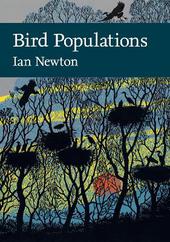
|
Bird Populations (Collins New Naturalist Library, Book 124)
Hardback
Main Details
| Title |
Bird Populations (Collins New Naturalist Library, Book 124)
|
| Authors and Contributors |
By (author) Ian Newton
|
| Series | Collins New Naturalist Library |
|---|
| Series part Volume No. |
Book 124
|
| Physical Properties |
| Format:Hardback | | Pages:608 | | Dimensions(mm): Height 222,Width 155 |
|
| ISBN/Barcode |
9780007429530
|
| Classifications | Dewey:598.17880941 |
|---|
| Audience | |
|---|
| Illustrations |
(200 colour photos and diagrams)
|
|
Publishing Details |
| Publisher |
HarperCollins Publishers
|
| Imprint |
William Collins
|
| Publication Date |
29 August 2013 |
| Publication Country |
United Kingdom
|
Description
Earlier naturalists formed the impression that bird numbers remained more or less stable through time. In the years since these words were written, however, changes have occurred in the landscapes of the British Isles and in the seas around our coasts, causing bird populations to fluctuate in an unprecedented way. In Ian Newton's latest New Naturalist volume, he explores bird populations and why their numbers vary in the way they do, from year to year or from place to place. He addresses the various factors that we know limit bird numbers - food supplies and other resources, competitors, predators, parasites and pathogens, and various human impacts. The combination of a rapidly expanding human population, a predominantly utilitarian attitude to land, central government policy on land use, and increasing mechanisation have combined to promote more massive changes in land use - and hence in bird habitats - in recent decades than at any comparable period previously. These developments have in turn brought huge changes in bird populations, as some species dependent on the old landscapes declined, and others benefiting from the changes increased. Over the same period, changing public attitudes to wildlife, protective legislation and a growing network of nature reserves allowed previously scarce bird species to recover from past onslaughts, while climate warming has promoted further changes. In this seminal new work, Ian Newton sets out to explain why different bird species are distributed in the numbers that they are, and have changed over the years in the way that they have. He emphasises the factors that influence bird numbers, rather than the numbers themselves, thus providing a much-needed overview which is necessary if we are to successfully manage bird populations, whether for conservation reasons, for sustainable hunting or for crop protection. The continued monitoring of bird numbers can also alert us to impending environmental problems. In addition, the regular watching and study of birds now provides a source of recreation and pleasure for very large numbers of people, who would find a world with fewer birds a poorer place.
Author Biography
Ian Newton is an ornithologist and applied scientist, and a leading expert on bird ecology and biogeography, specialising in finches, waterfowl and birds of prey, especially the sparrowhawk. He graduated from Bristol University and gained his doctorate in finch behaviour at Oxford, followed by research on bullfinch damage in orchards. He joined the NERC in 1967, initially studying population ecology of geese and finches, followed by the impact of pesticides on birds of prey. He has written two previous New Naturalist volumes, Finches (1972) and Bird Migration (2010).
ReviewsWinner of the British Ecological Society's 'Marsh Ecology Book of the Year' Award 'This book is a landmark edition in an already outstanding natural history series, and will make an extremely valuable and treasured addition to the library of anyone serious about birds and their biology.' Seabirds Praise for Ian Newton's previous New Naturalist Bird Migration: 'Truly outstanding - the product of a lifelong inquiry into the annual travels of birds.' Guardian 'The New Naturalist series strikes gold with this insight into ultimate avian journeys.' BBC Wildlife '... a work of authority.' The Daily Telegraph
|